Beetles, belonging to the order Coleoptera, are a diverse group of insects that can be found in a variety of habitats across the globe. With over 400,000 known species, they make up an astonishing one-quarter of all animal lifeforms and represent a significant portion of the insect population. This incredible diversity makes them a subject of great interest for entomologists and nature enthusiasts alike.
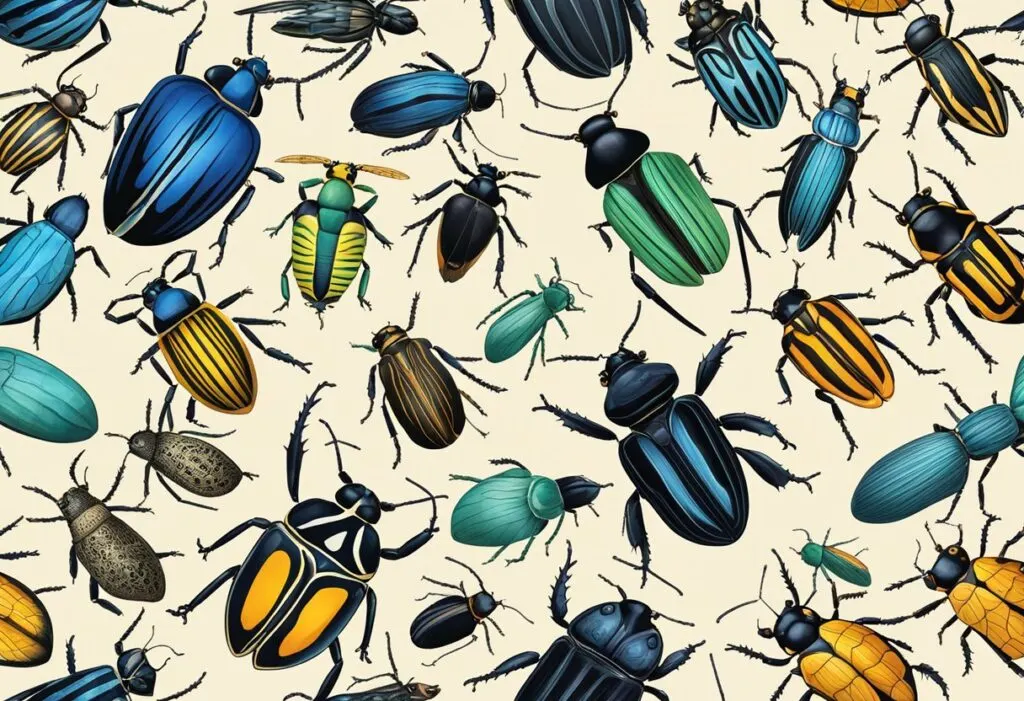
Different types of beetles display a wide range of physical characteristics, including size, color, and shape.
Still, they all share traits such as hard, protective wings called elytra and distinctive chewing mouthparts. Among the more recognizable types of beetles are the ladybugs (Coccinellidae), potato bugs (Leptinotarsa decemlineata), and lightning bugs (Lampyridae). Other varieties include darkling beetles (Tenebrionidae), which are nocturnal and known for burrowing under rotting wood, and clay-colored billbugs (Sphenophorus aequalis).
Identifying the numerous beetle species can be complex, and an informative beetle identification chart is often necessary for amateur and professional observers. From the vibrant and colorful to the tiny and pesky, these various beetle types provide a fascinating glimpse into the immense diversity of the insect world.
Key Points
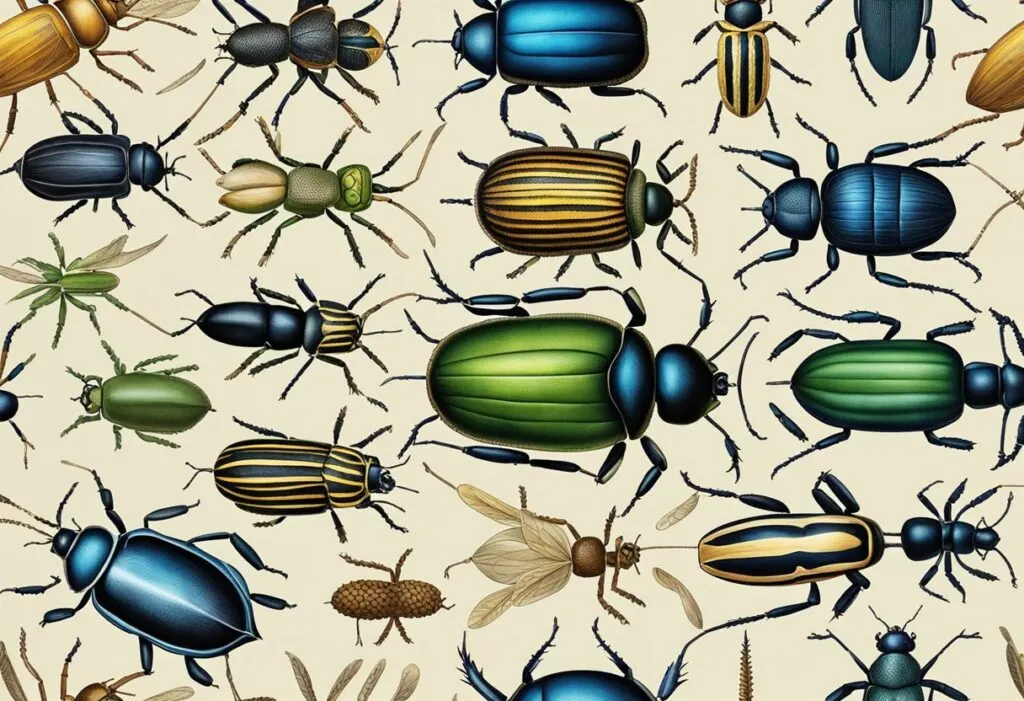
Beetles are an incredibly diverse group of insects, with over 400,000 known species worldwide. They play crucial roles in the ecosystem and can be found in various environments, from forests to deserts. In this section, we will delve into some key points about beetles that highlight their importance and diversity.
One of the most distinguishing features of beetles is their wings, which are modified into hard shell-like coverings called elytra. These protective wings encase a second set of membranous wings that enable the beetle to fly. This unique adaptation sets them apart from other insects and provides a level of protection from predators and the elements.
There are numerous types of beetles, each having their distinct characteristics and roles in the ecosystem. For instance, ladybugs are popular for their vibrant colors and their appetite for aphids, making them beneficial for controlling pests in gardens and agricultural fields. Tiger beetles, on the other hand, are known for their speed and predatory behavior, feeding on smaller insects.
Dung beetles have a particularly important role in the ecosystem, as they help break down and decompose animal waste. This process not only aids in nutrient recycling but also reduces potential habitats for disease-carrying organisms. Additionally, some beetles, such as the lightning bug or firefly, are known for their bioluminescence, which plays a crucial role in their mating behavior and communication.
Beetles can also be agricultural pests, with species such as the potato bug and clay-colored billbug causing significant damage to crops. These insects feed on the leaves, roots, and even the tubers of plants, leading to reduced yield and quality.
Ladybug
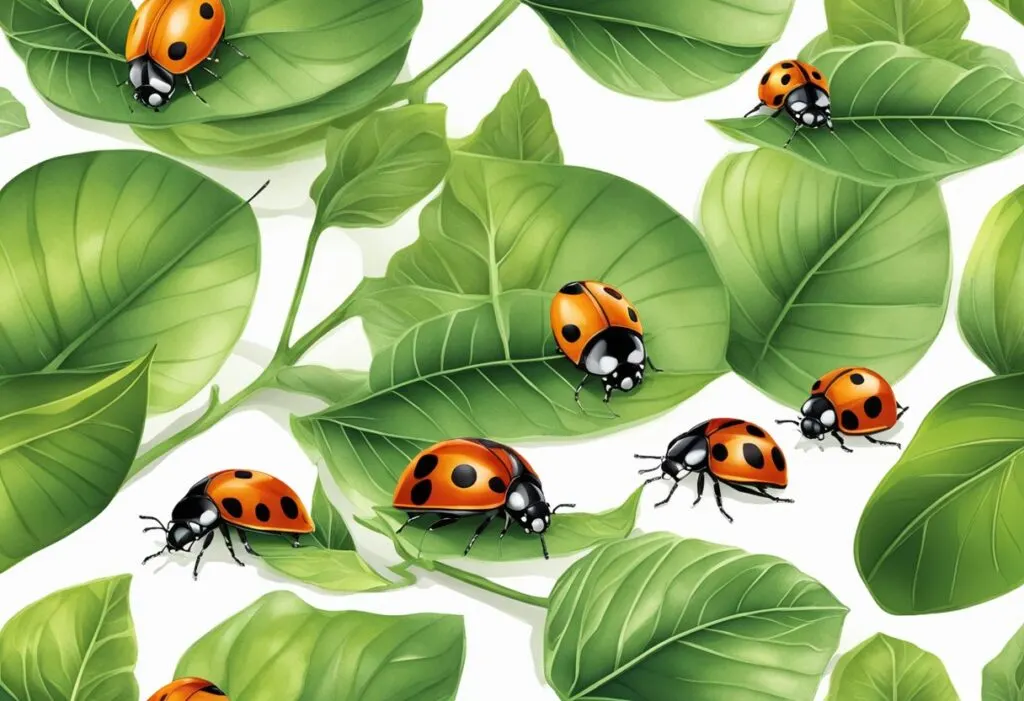
Ladybugs, also known as ladybirds and lady beetles, belong to the family Coccinellidae, which consists of approximately 5,000 widely distributed species. These beetles are small and hemispheric in shape, typically having red, oval-shaped bodies adorned with black spots. However, some ladybugs exhibit alternative colors like yellow, orange, black, gray, or even pink.
Apart from their attractive appearance, ladybugs play a vital role in maintaining the health of gardens and agricultural fields by preying on plant pests like aphids and scale insects. This makes them highly beneficial insects in the ecosystem. It is essential to distinguish ladybugs from look-alike beetles that can be destructive to plants, such as the Mexican bean beetle, squash lady beetle, clerid beetles, scarlet lily beetles, and Colorado potato beetles.
Within the ladybug species, there are some invasive types, such as the multicolored Asian lady beetle, which resembles a yellow ladybug. This particular beetle, despite sharing similarities with its counterparts, has become an unwelcome pest.
Carrion Beetles
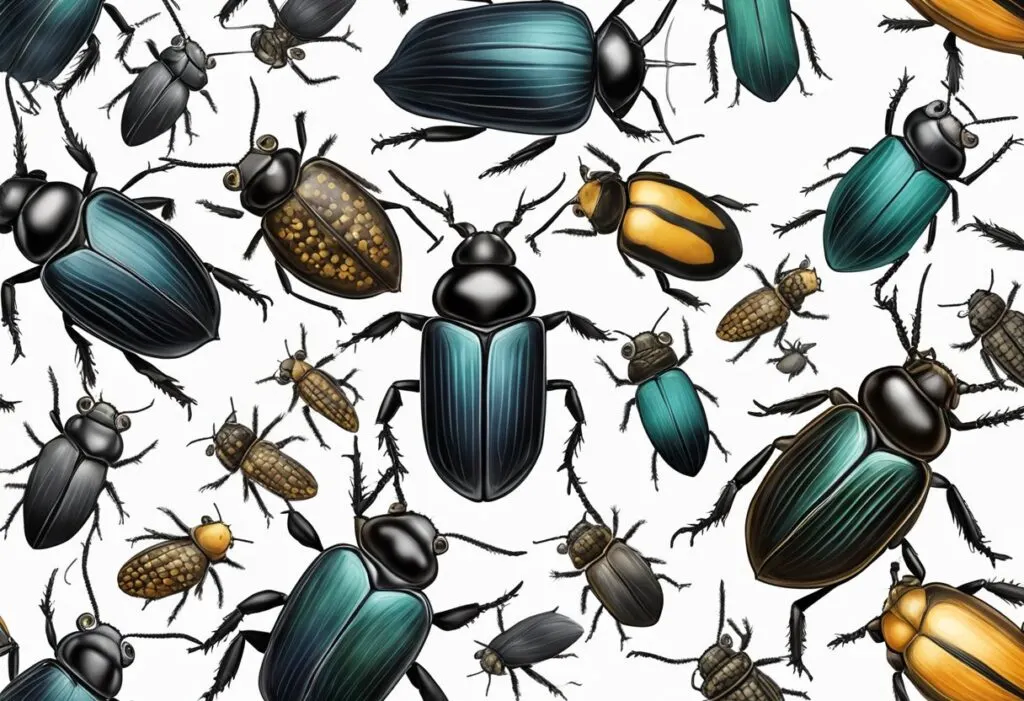
Carrion beetles, belonging to the Silphidae family, play a crucial role in nature by feeding on dead organic matter, primarily carrion. Both adult and larval stages hold this dietary preference. These beetles are essential in the decomposition process, clearing away dead animals, and helping control the population of fly larvae and other carrion beetle species that compete for the same resources.
One of the well-known members of this family is the American Carrion Beetle (Necrophila americana). This North American native beetle lays its eggs in and consumes raw flesh, specifically dead animals, and fungi. Its larvae share a similar diet, feeding mainly on decomposing carcasses.
Another notable carrion beetle is the Black Sexton Beetle (Nicrophorus humator). Like the American Carrion Beetle, it feeds on decomposing flesh and also plays a crucial role in breaking down dead organisms and recycling nutrients back into the ecosystem.
The American Burying Beetle (Nicrophorus americanus) presents another fascinating example within the Silphidae family. This beetle is termed a “burying beetle” for its extraordinary ability to bury small carcasses, which it later uses for food and reproduction. Burying beetles are essential in the ecosystem as they help prevent the spread of diseases from decaying carcasses.
Distinctive physical characteristics of carrion beetles include a flattened body, typically black, often adorned with markings of red, orange, or yellow. The shell-like forewings (elytra) show a unique shape, being wider toward the end of the body and narrower at the front.
See Related: Best Eco-Friendly Baby Products to Buy Today
Rove
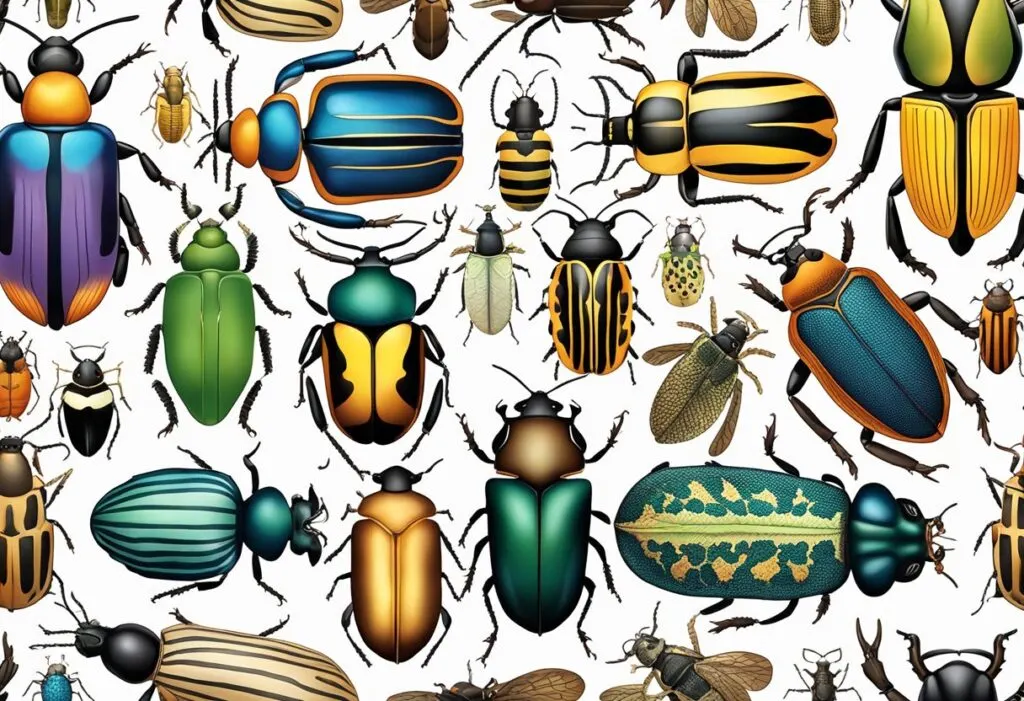
Rove beetles, belonging to the family Staphylinidae, are a diverse group of insects with over 63,000 known species worldwide. Their characteristic elongated abdomens resemble the barrel of a revolver, which has earned them their unique name. Despite their small size, ranging from 1 to 40 millimeters in length, these beetles have a marked presence in various habitats.
These beetles are widely distributed and can be found in every type of habitat in which beetles occur. Their diets are quite diverse, including almost everything except for the living tissues of higher plants. Interestingly, the discovery of the diet of Himalusa thailandensis revealed that some rove beetles do consume higher plants.
Known for their peculiar habit of raising the ends of their bodies like a scorpion when disturbed or frightened, rove beetles may initially appear to be threatening. However, they cannot sting or bite and are generally harmless to humans. One exception is the production of pederin, a toxin that can cause contact dermatitis if handled.
Rove beetles are generally nocturnal, although a few species like Stenus and Paederus are active during daylight hours. Many rove beetles are black with light, almost translucent legs, and their elongated bodies usually demonstrate four distinct segments: head, thorax, shortened elytra, and a long, slender abdomen. This body shape is similar to that of an earwig, but without the pincers.
The mobile larvae of nonparasitic rove beetles may have distinctly segmented bodies. Stenus, Astenus, and a few other species spin a cocoon before pupating. In general, adult rove beetles are relatively long-lived, adding to their ecological significance. In gardens, rove beetles can be considered beneficial insects as they help control pests by preying on various soil-dwelling insects and their eggs.
Ground
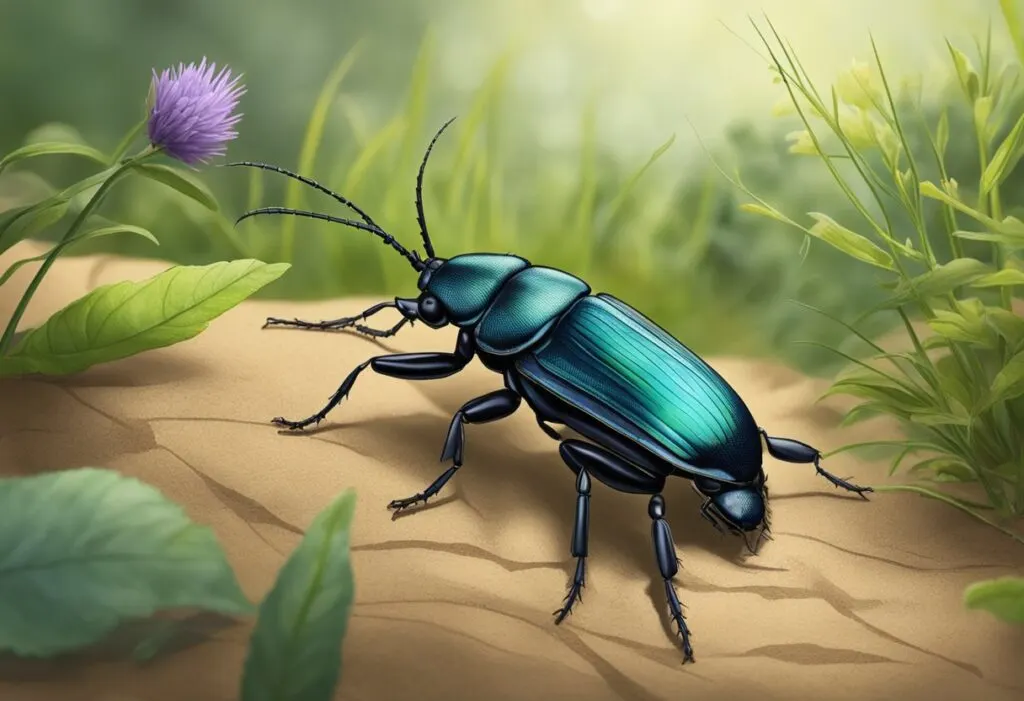
Ground beetles, belonging to the family Carabidae, are small insects with relatively long legs and powerful pinchers. They are one of the most common groups of beetles in North America and can be found in various types of environments, including forests, fields, shorelines, and agricultural areas. This cosmopolitan family includes more than 40,000 species worldwide, with around 2,000 species in North America and 2,700 in Europe.
These beetles are beneficial to the environment as they feed on common crop and plant pests, helping to control their populations. They are also found in landscapes and around homes, particularly in August. However, ground beetles can sometimes become a nuisance inside buildings.
Ground beetles exhibit various colors, with some species being an iridescent blue or green. They can typically be found under leaves or debris, in cracks in the soil, or running along the ground. Some species also climb trees, shrubs, and crop plants in search of prey. Adults move quickly when disturbed but rarely fly. Additionally, certain species emit a strong-smelling irritant when handled.
Despite their large global presence, ground beetles remain understudied in some regions. More research may uncover the myriad ways these insects contribute to ecosystems and offer valuable insights into their biology and conservation needs.
See Related: Milk Snake vs Corn Snake: Unraveling the Differences
Flesh-eating beetles
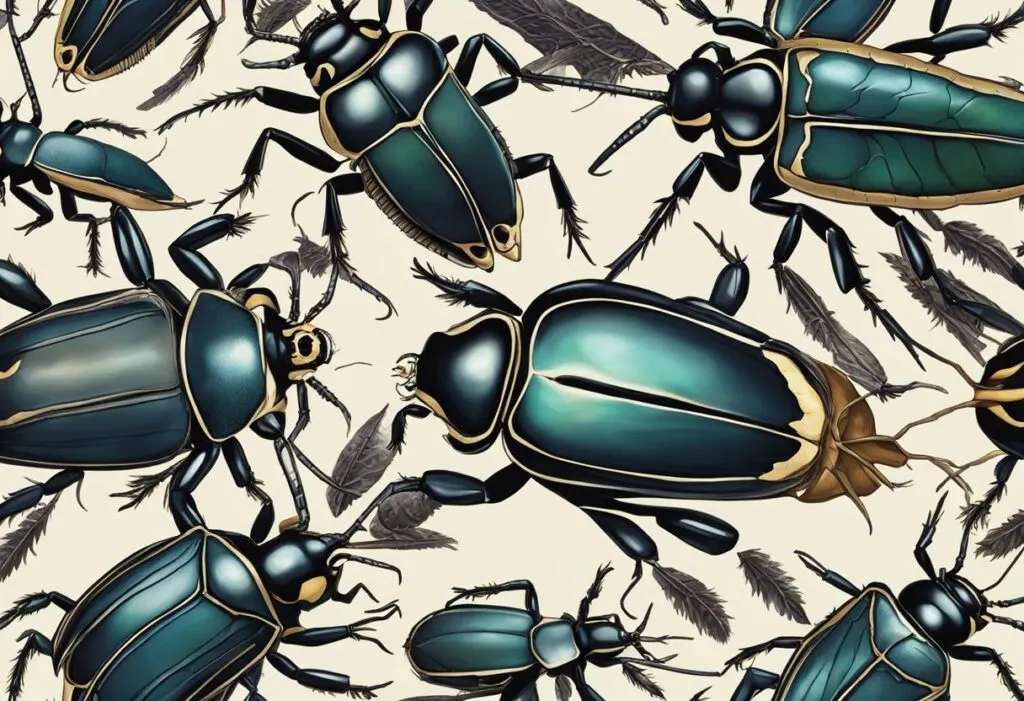
Flesh-eating beetles, also known as skin beetles or hide beetles, form an essential part of our ecosystem. They scavenge on decomposing bodies, contributing to the cleanliness and overall health of the planet. These beetles primarily belong to the Dermestidae family and showcase a preference for organic materials.
These small beetles, typically ranging between 1-12 mm in length, possess rounded to oval shapes with hairy or scaly elytra. The distinctive patterns on their elytra can often be vibrant with contrasting colors. Their antennae are club-shaped, providing a primary distinguishing feature of this species.
Beyond their feeding habits on decomposing bodies, these adaptive beetles can also consume a variety of organic materials, including grains, plants, animal fibers, natural fibers, feathers, and even dead insects. The U.S. Fish and Wildlife Service Forensics Laboratory highlights that dermestids can also eat their way through materials like old books, carpets, and woolens.
In cases of suspicious deaths, flesh-eating beetles can prove to be crucial to forensic entomologists in investigations. Carrion-feeding beetles enable these experts to gather evidence and determine circumstances around a victim’s demise. These insects play a vital role in the natural decomposition process, by feeding on both the carrion itself and the insects that are attracted to the carcasses.
Despite their somewhat unsettling dietary habits, flesh-eating beetles are indispensable in maintaining the ecological balance, particularly in the decomposition process of organic materials. These fascinating creatures are not only resourceful but integral to the well-being of our environment.
Scarab
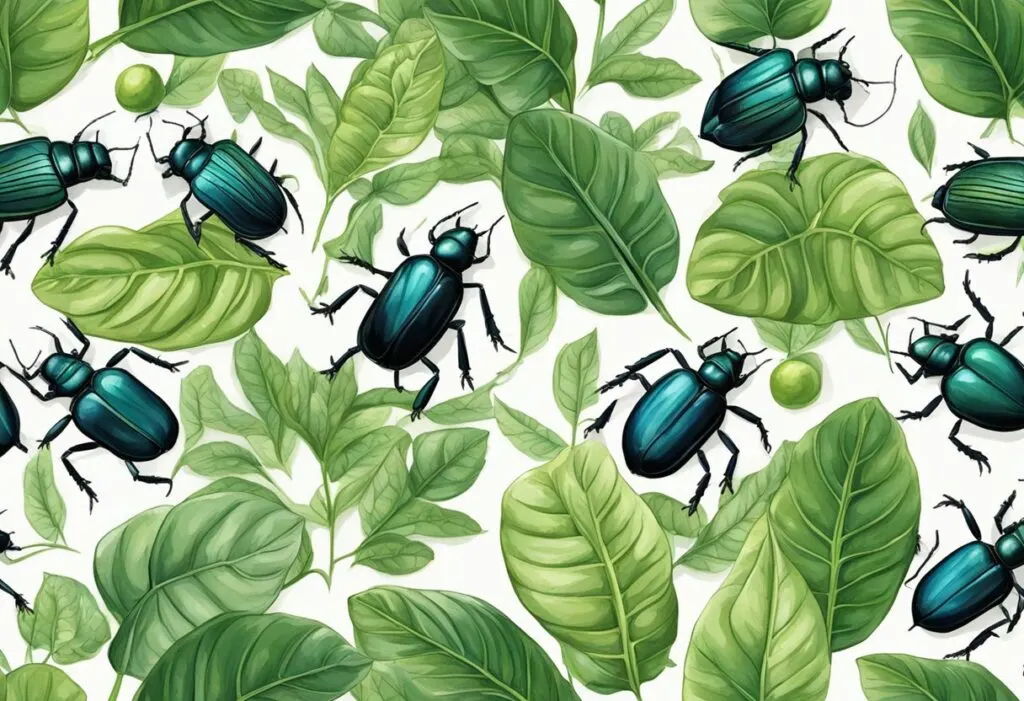
The Scarab beetle is a fascinating group of insects belonging to the Scarabaeidae family, which consists of approximately 30,000 species. These beetles are known for their compact, heavy-bodied, and robustly oval outlines, making them a distinctive group within the Coleoptera order.
Some well-known members of the Scarabaeidae family include Japanese beetles, dung beetles, June beetles, rose chafers – which can be Australian, European, or North American –, rhinoceros beetles, Hercules beetles, and Goliath beetles. Each of these species contributes to the diverse and unique collection of scarabs that can be found worldwide.
One interesting species is the Japanese beetle (Popillia japonica), an invasive species in the United States responsible for widespread damage to vegetation due to the lack of natural predators. This beetle is characterized by its copper-like elytra and shiny green, almost metallic thorax, and head.
On the other hand, the Egyptian scarab beetle holds a particular historical relevance, as it has been adorned in jewelry for centuries. These beetles have a unique feature – their front legs do not end in any discernible tarsus or claw, only having a small claw-like feature which could aid in excavating. An Egyptian scarab’s size ranges from 25 to 37 mm.
Dung Beetles
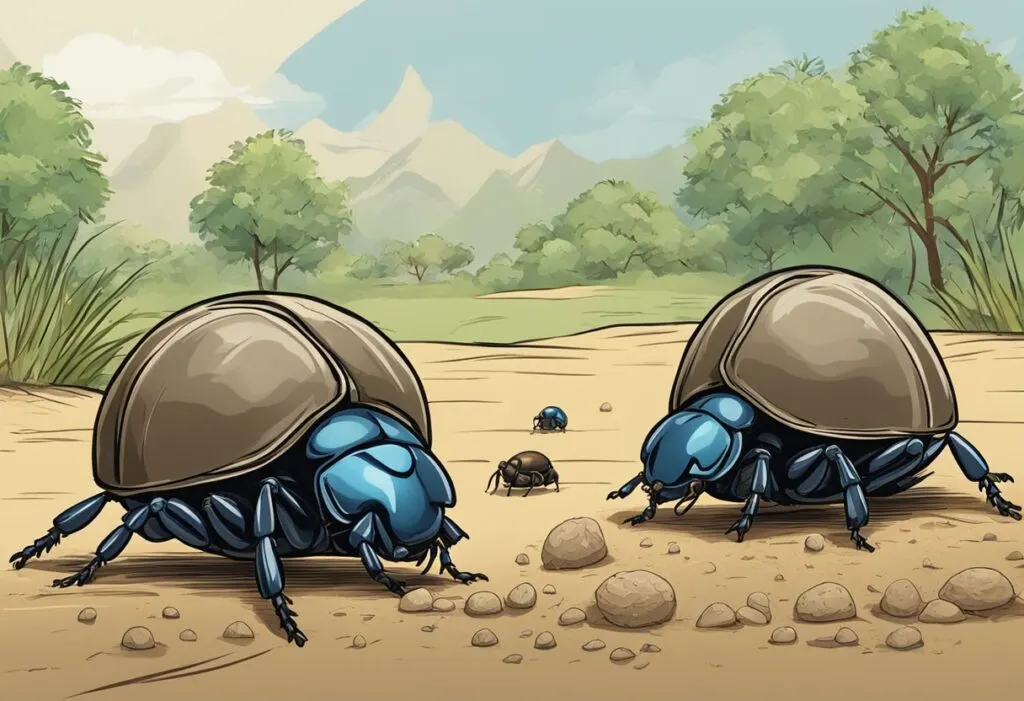
Dung beetles are a diverse group of insects belonging to several families within the order Coleoptera. These beetles have the unique behavior of feeding on and utilizing animal dung for various purposes, such as food and breeding sites. There are three main types of dung beetles: rollers, tunnelers, and dwellers.
Rollers are dung beetles that carefully shape dung into balls, which they then roll away from the main dung heap. Rollers utilize these dung balls for two primary reasons: the female beetle deposits her eggs within the ball, creating a brood ball, or the adults consume the balls as a food source.
Tunnelers, as the name suggests, dig tunnels beneath dung piles. They transport dung into these tunnels, where they lay their eggs. Tunneling dung beetles are known to create intricate underground networks and efficiently store their food and eggs within these tunnels for safekeeping.
Dwellers, also called endocoprids, are dung beetles that burrow, lay eggs, and feed within or just below a fresh dung pile. They do not create dung balls or tunnels like their counterparts but instead take advantage of the nutrients and protection provided by the dung heap itself.
Each type of dung beetle has its unique evolutionary adaptations and behaviors that allow them to thrive in specific environments. For example, rollers are often found in grasslands and savannas, where large herbivores produce an abundant supply of dung. Tunnelers and dwellers, on the other hand, are more common in forests or pastures, where they can burrow into the soil and access nutrients more easily.
Dung beetles are crucial to maintaining healthy ecosystems, as they help break down nutrient-rich animal waste and recycle it back into the soil. This process not only benefits plants but also prevents the buildup of harmful gases and pests associated with decomposing dung.
Stag Beetles
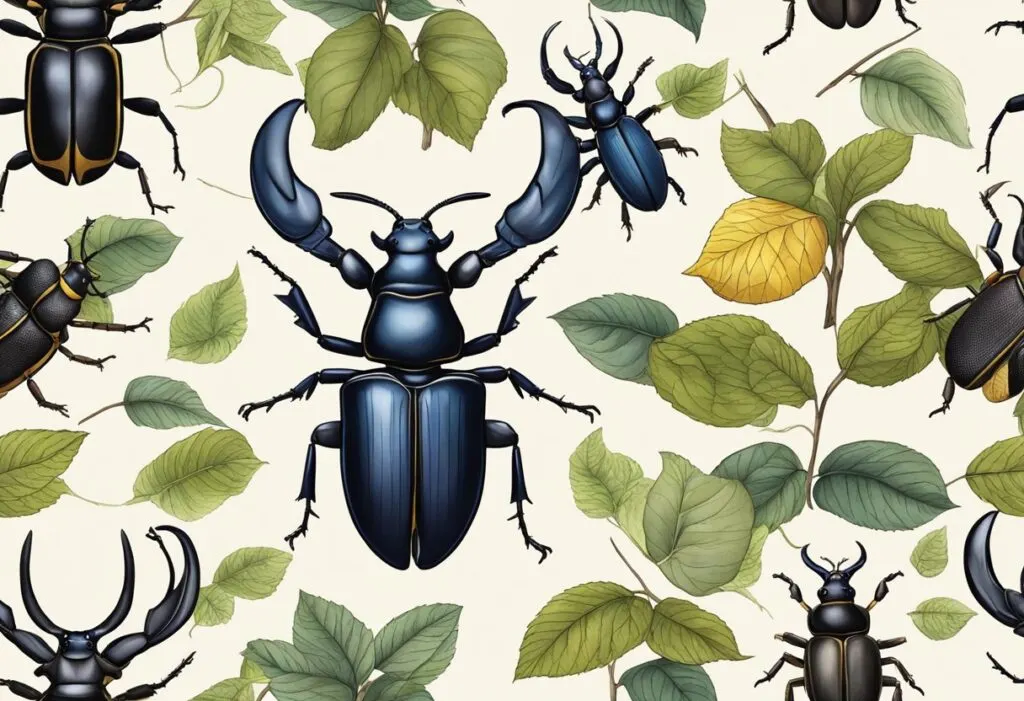
Stag beetles belong to the insect family Lucanidae and are known for their large and distinctive mandibles, which resemble the antlers of stags. These impressive beetles can be found in various habitats, including woodlands, parks, hedgerows, and gardens.
There are approximately 1,200 different types of stag beetles scattered worldwide, displaying a wide array of colors, sizes, and habits. Although they can be quite common in the United States, stag beetles also inhabit regions in Europe, Asia, and Australia.
Males of many Lucanid species are easily recognizable due to their long, elaborately branched, and toothed mandibles. In some cases, these mouthparts can be as long as the beetle itself. While these beetles are sometimes referred to as pinching bugs, they are generally harmless to humans. Their impressive mandibles are not meant for biting, but instead are used for fighting and competing over mates.
Stag beetles can provide benefits to gardens and ecosystems, as they primarily feed on decaying wood and other detritus. This helps recycle nutrients in the environment and contributes to healthy, functioning ecosystems.
Mountain Pine
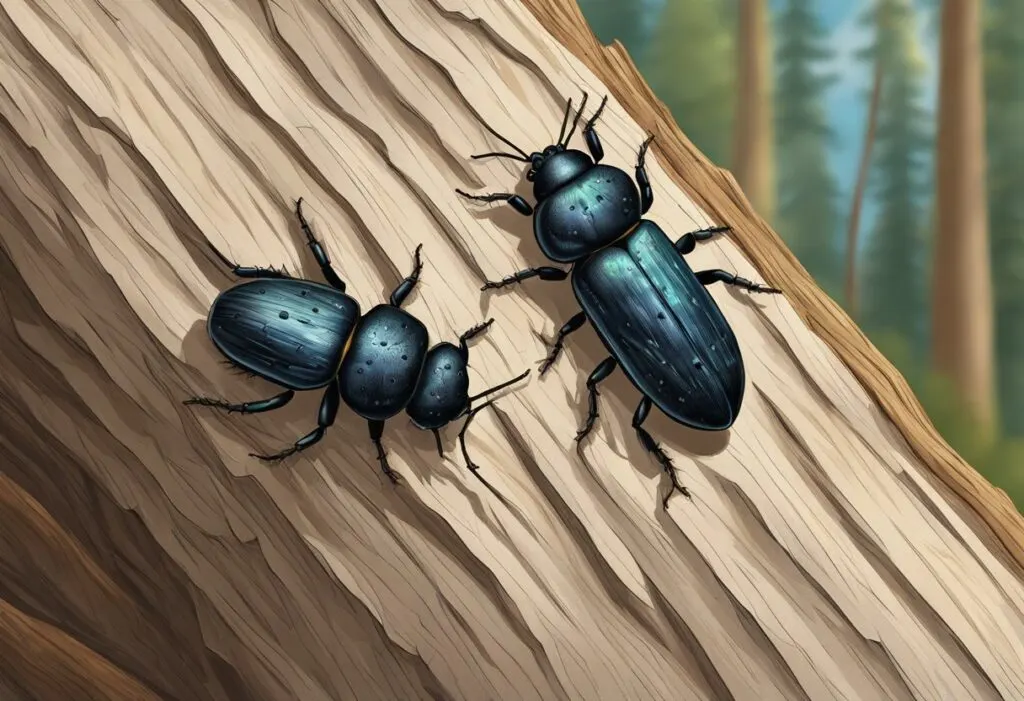
The mountain pine beetle (Dendroctonus ponderosae) is a species of bark beetle native to the forests of western North America, spanning from Mexico to central British Columbia. These beetles have a hard black exoskeleton and measure about 5 millimeters long – roughly the size of a grain of rice.
These beetles predominantly infest various pine species, including ponderosa pine (Pinus ponderosa), lodgepole pine (P. contorta), and limber pine (P. flexilis). As the mountain pine beetle bores into a tree, conspicuous masses of pitch, known as pitch tubes, form on the tree bole at entry points. These pitch tubes are cream to red-colored, and about 13 to 25 mm (1/2 to 1 in) in diameter.
Mountain pine beetles have had a significant impact on the forests of North America for thousands of years. A changing climate, coupled with warmer temperatures and drought conditions, has led to an unprecedented increase in the size and severity of mountain pine beetle infestations. In turn, this has resulted in widespread tree mortality, altering forest composition and structure.
While mountain pine beetles are destructive pests for pines, they also serve as an essential component in the ecological balance of North American forests. By killing older and weaker trees, these beetles create room for younger, healthier trees to thrive. Additionally, dead trees that remain standing or fall to the ground provide habitats for various wildlife species and contribute to the recycling of nutrients back into the soil.
See Related: What is a Pellet Stove, and how does it work?
Weevil
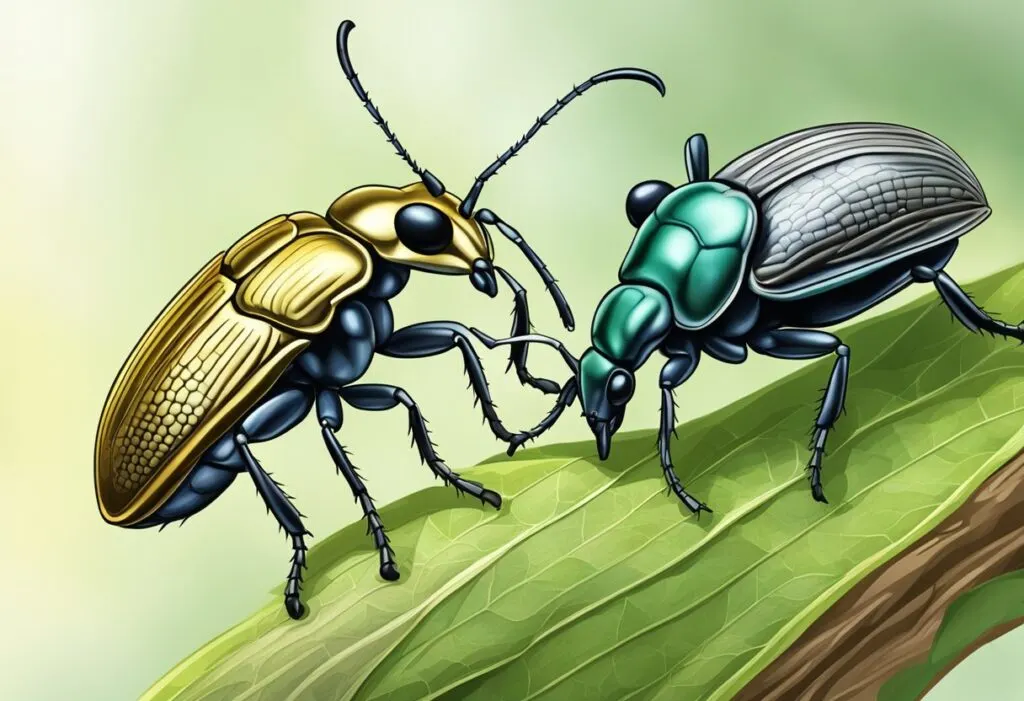
Weevils are a diverse group of beetles belonging to the Curculionidae family and the Curculionoidea superfamily. These small, herbivorous insects are often less than 6 millimeters (¼ inch) in length and are easily recognized by their unique elongated snouts. Their typical physical features, like the long snout and elbowed antennae, set them apart from other beetles.
Over 50,000 weevil species exist worldwide, with many serving as significant agricultural and household pests. Some common types of weevils include:
- Asian Oak Weevil (Cyrtepistomus castaneus): A common species found in the United States, these weevils are particularly associated with feeding on oak leaves.
- Green Immigrant Leaf Weevil (Polydrusus formosus): These small green weevils are known to damage foliage of ornamental shrubs and trees.
- Peach Root Weevil: Invading the root systems of peach trees, these weevils can cause harm to the overall growth and yield of the tree.
Weevils display unique behaviors in response to their environment. For example, many species feign death by tucking in their legs and lying motionless on their backs when disturbed. In addition to playing dead, weevils engage in various plant-eating activities, such as leaf rolling in the case of the Attelabidae family, and feeding on the pine flowers among Nemonychidae species.
While some weevils are considered pests, their ecological roles shouldn’t be overlooked. They participate in the natural cycles of decomposition by feeding on dead plant materials, dispersing seeds, and even facilitating the process of pollination for certain plant species. Understanding the diverse weevil types and their behaviors is essential for both researchers studying beetle ecology and for individuals working to manage pest populations.
Soldier Beetles
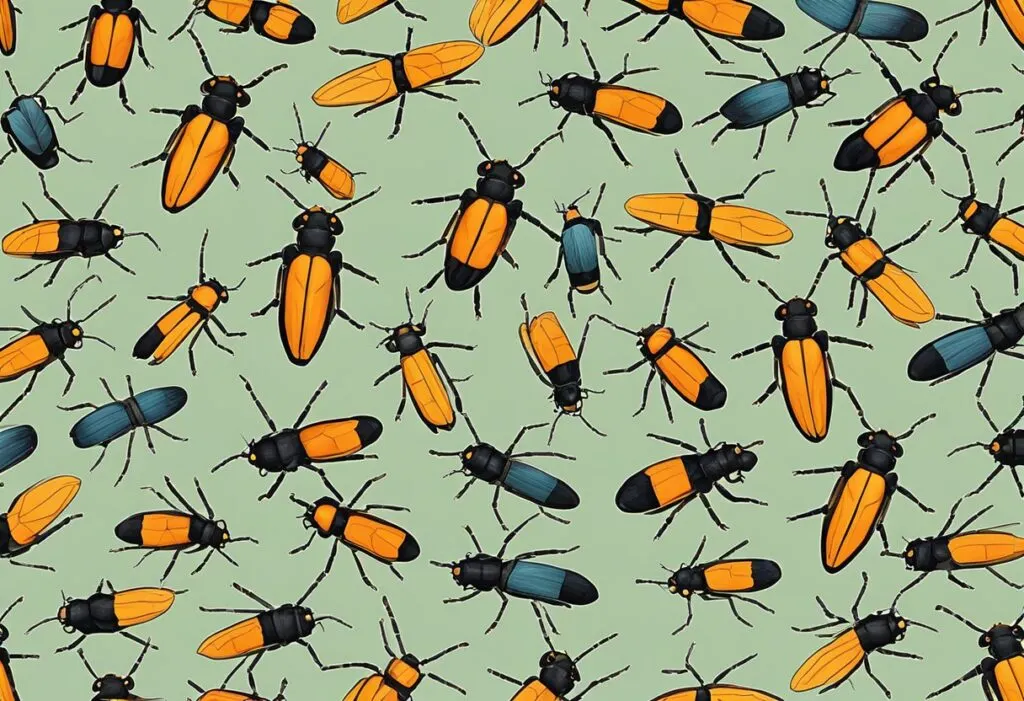
Soldier beetles, belonging to the family Cantharidae, are a diverse group. Named after one of the first species observed with a color pattern similar to early British soldiers in red coats, they can be found in various parts of the world. They exist in different colors and patterns, making them a fascinating subject within the beetle species.
A common North American soldier beetle, Chauliognathus marginatus, has an orange head and legs, while Chauliognathus pensylvanicus, typically found on goldenrod, boasts a yellow body with black spots. In Europe, notable genera include Cantharis and Rhagonycha.
The soldier beetles’ life cycle consists of wintering as larvae, during which they can be found in areas with high humidity, such as leaf litter, plant debris, and loose soil. Their main diet includes insect eggs and larvae. In early summer, these larvae transform into pupae, and adult soldier beetles start to emerge from late July through August and even into September.
As beneficial insects, soldier beetles play a role in controlling garden pests. They help keep the ecosystem in balance by preying on soft-bodied insects such as aphids, caterpillars, and mites. Additionally, adult soldier beetles are known to feed on pollen and nectar from flowering plants, which aids in pollination and supports plant diversity.
Firefly
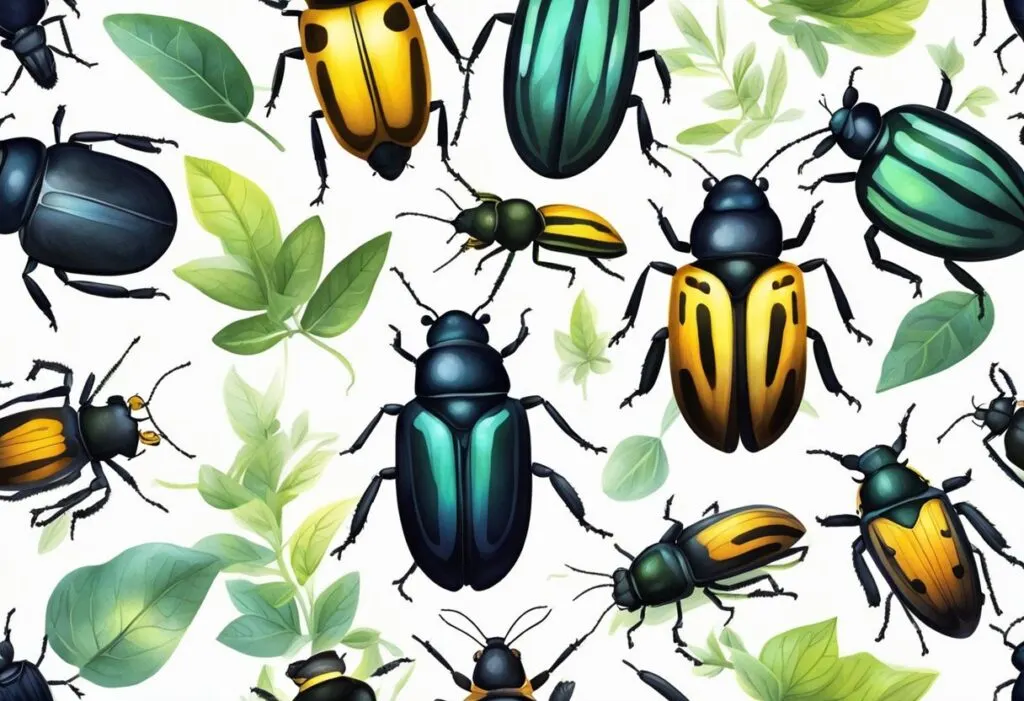
Fireflies, also known as lightning bugs, are a fascinating group of beetles belonging to the family Lampyridae. There are about 2,000 species of fireflies found in both tropical and temperate regions. These insects are well-known for their light-producing organs on the underside of the abdomen, which they use for communication purposes, especially during mating rituals.
One common North American species is the Common Eastern Firefly (Photinus pyralis), which has a black ventral side and can grow up to 1 cm in length. The light signals of these beetles play an integral role in their ecosystems, as males and females communicate through bioluminescent flashes. It is believed that these beetles can also keep spiders away.
Fireflies display a range of feeding habits, with most species’ larvae being specialized predators. They consume other larvae, terrestrial snails, and slugs as their primary food source. Certain firefly species have evolved grooved mandibles that deliver digestive fluids directly onto their prey, aiding in their consumption. Adult fireflies, on the other hand, typically feed on nectar.
In North America, the most familiar fireflies belong to the Lampyridinae subfamily, specifically the Photinini tribe. Not all members of this subfamily emit light, but those that do are generally divided into multiple closely related species. Photinus fireflies are known to be the most common fireflies in this region.
Firefly populations can be significantly impacted by human activity, such as habitat loss, light pollution, and pesticide usage. These factors may lead to a decline in firefly populations, potentially disrupting their natural ecosystems. Therefore, it is essential to understand the various species of fireflies and their roles in the environment to support conservation efforts.
Potato Bug
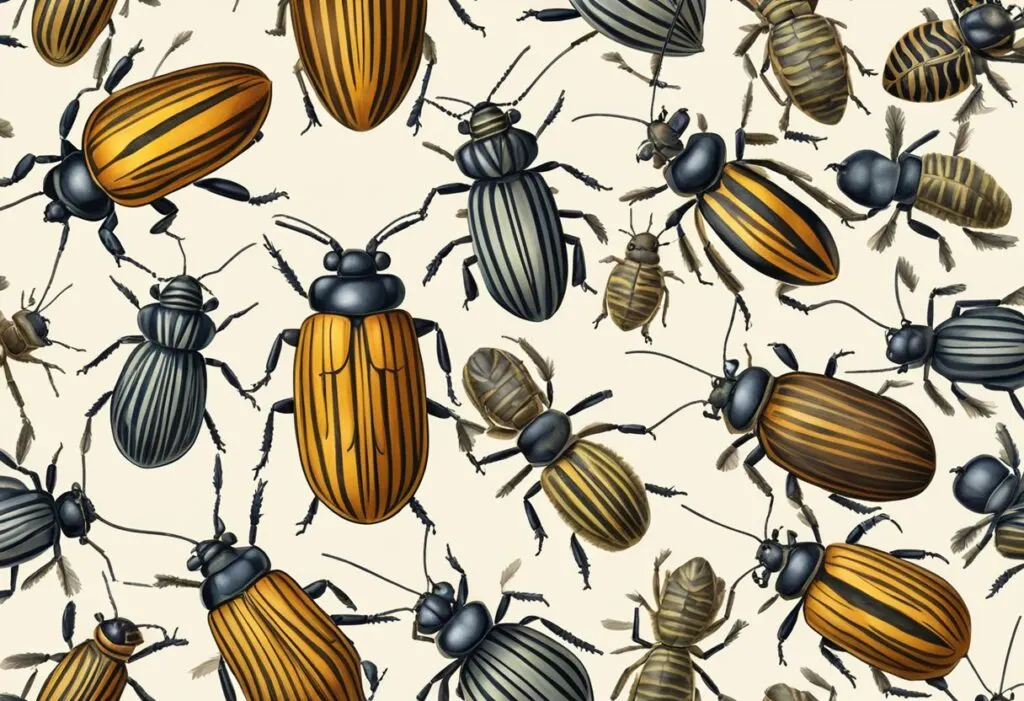
The potato bug, also known as the Colorado potato beetle (Leptinotarsa decemlineata), is a significant pest of potato crops. This beetle is approximately 10 mm long, with a distinctive bright yellow or orange body and five bold brown stripes along the length of each of its elytra. Originally native to the Rocky Mountains, the Colorado potato beetle has spread rapidly, affecting potato crops in various regions.
Belonging to the genus Leptinotarsa, there are over 40 species in California and South America. At least 10 of these species can be found north of Mexico. The potato bug is a part of the order Coleoptera, which also includes other known beetles like ladybugs (Coccinellidae), lightning bugs (Lampyridae), and clay-colored billbugs (Sphenophorus aequalis).
The life cycle of the Colorado potato beetle starts from its emergence in spring, around the same time when potato plants begin to grow. Both the larvae and adults of this beetle are known to feed on the leaves of potato plants, posing a threat to the crop as they can completely defoliate it.
In order to protect potato crops from the damage caused by potato bugs, several control methods can be utilized:
- Monitoring: Regularly inspecting potato plants for signs of infestation is crucial in detecting and managing the potato bug population.
- Crop rotation: Rotating potato crops with other non-host plants can help break the life cycle of the beetles.
- Natural predators: Encouraging the presence of natural predators such as ladybugs or lacewings in the garden can aid in reducing the potato bug population.
- Hand-picking: Manually removing and destroying adult beetles and larvae can be effective in small gardens.
By using a combination of these control methods, it is possible to mitigate the negative impact of potato bugs on potato crops and maintain a healthier environment.
Leaf Beetles
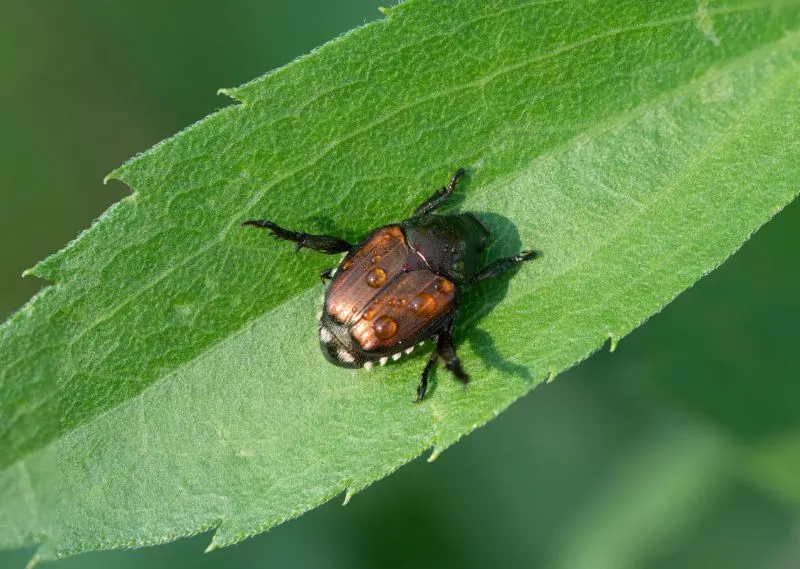
Leaf beetles belong to the family Chrysomelidae, which comprises approximately 35,000 species found worldwide, particularly in the tropics. These beetles are characterized by their oval or round shape, short legs, and lack of notches in their eyes. Their antennae are typically no more than half the length of their body.
These beetles are known as plant-eating insects, commonly found in gardens, feeding on various types of leaves. Some well-known leaf beetles include the Colorado potato beetle, the larvae of which feed on potato, eggplant, pepper, and tomato plants. Another example is the cucumber beetles, which consist of several species that feed on vegetable plants.
Some leaf beetles display fascinating features, such as the frog-legged beetles or kangaroo beetles (Lamprosomatinae). Their unique leg structure enables these insects to move quickly and jump when threatened, much like frogs or kangaroos.
Coconut Hispine
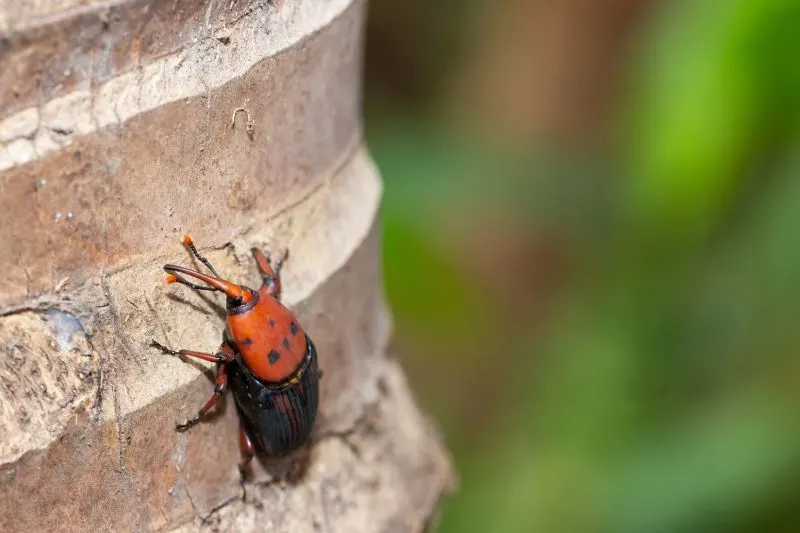
The Coconut Hispine Beetle (Brontispa longissima) is a destructive plant pest that primarily targets coconut palm trees, causing extensive damage to their foliage. It is particularly widespread throughout Asia, Southeast Asia, and Oceania, which includes countries such as American Samoa, Australia, French Polynesia, New Caledonia, Papua New Guinea, Samoa, Solomon Islands, Vanuatu, and Wallis & Futuna.
Adult Coconut Hispine Beetles lay their eggs between the leaflets of the spear leaf, which is the youngest and still folded leaf in a palm. Upon hatching, the larvae begin feeding on the soft tissue of the leaf, leaving large areas of decay. When these larvae become adults, they continue to damage the leaves, causing further decay. The most vulnerable variety of coconut palms to this pest is the Malayan Dwarf.
As a result of the Coconut Hispine Beetle’s feeding habits, the affected leaves often become severely decayed, with large portions appearing brown and necrotic. This damage not only limits the tree’s ability to photosynthesize, but also weakens its overall health and compromises its fruit yield. Consequently, infestations can have a significant impact on the coconut industry, affecting the livelihoods of farmers and communities dependent on coconut production.
To manage and control the Coconut Hispine Beetle, several measures can be employed. These include biological control agents, such as the introduction of natural predators like parasitic wasps, as well as cultural management practices that involve the regular inspection and removal of infested plant parts.
Japanese Beetles
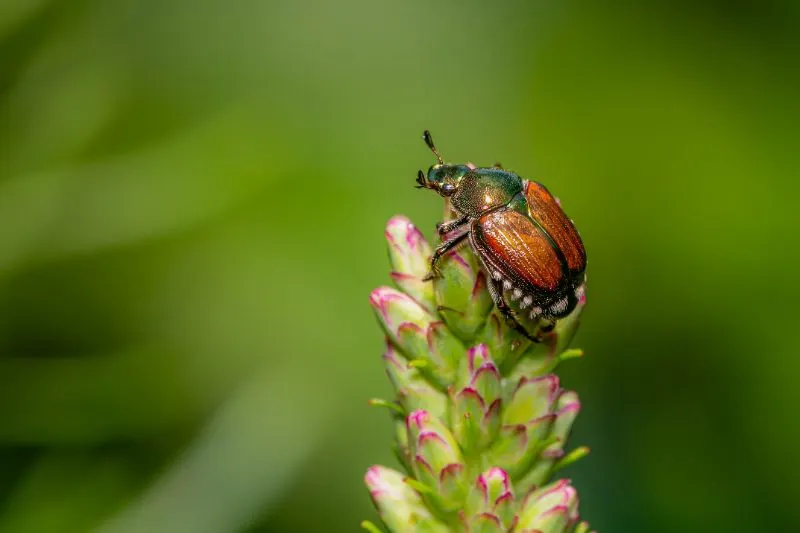
Japanese beetles (Popillia japonica) are invasive species known for their iridescent green heads and thoraxes, and copper-colored elytra. Measuring around 15 mm (0.6 in) in length and 10 mm (0.4 in) in width, these beetles can be identified by the five distinguishable white tufts along their abdominal sections.
Originating from Japan, the species was introduced to the United States in the early 1900s and has since become a major agricultural pest. Japanese beetles feed on over 300 species of plants including flowers, fruits, and leaves, with a preference for roses, grapes, raspberries, and green beans.
In addition to the damage they cause as adults, Japanese beetle larvae, known as grubs, are also highly destructive. Grubs feed on grass roots, causing the turf to brown and die. This damage often results in a loose carpet-like appearance on affected lawns and gardens.
Due to the harmful impact on plants and turfgrass, homeowners, gardeners, and farmers must actively work towards controlling Japanese beetles. Common methods include:
- Physical removal: Hand-picking beetles from plants daily and placing them into a container of soapy water to kill them.
- Traps: Commercially available beetle traps can be deployed to lure and catch the pests.
- Biological control: Introducing natural predators, such as parasitic wasps or nematodes, can help manage beetle and grub populations.
However, it is essential to note that using traps may sometimes attract more beetles to the area. The trap should be placed strategically, away from the plants you want to protect.
Despite the challenges that Japanese beetles bring, they are a fascinating type of insect. Their striking appearance, coupled with the damage they cause to plants, make them a notable species within the beetle family.
Whirligig
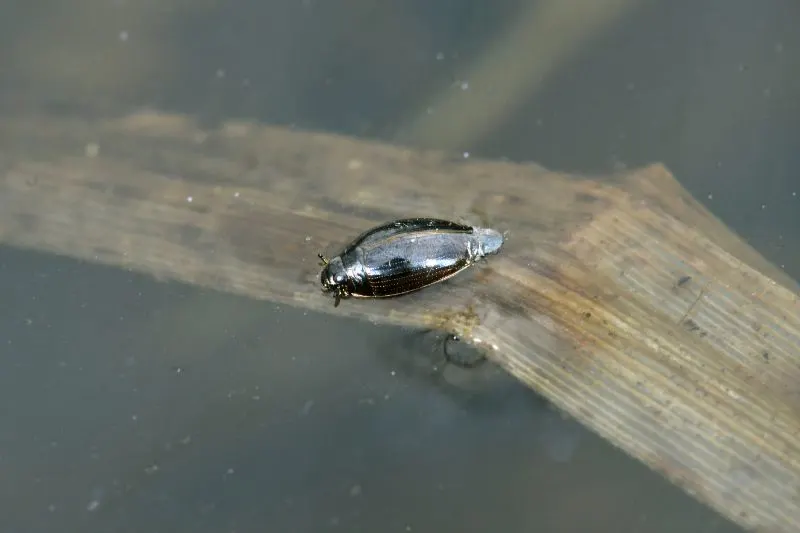
The whirligig beetle is an intriguing member of the beetle family (Gyrinidae), known for its unique swimming behavior and distinctive eye structure. Found across the globe, there are approximately 700 species of whirligig beetles dedicated to patrolling the surfaces of still ponds and lakes.
The most distinctive feature of whirligig beetles is their divided eyes, which are believed to enable them to see both above and below the water’s surface simultaneously. This adaptation makes them highly efficient predators, preying on insects, small aquatic organisms, and other creatures that share their aquatic environment.
Whirligig beetles are notorious for their peculiar swimming patterns. When alarmed, they dart across the water’s surface in rapid circles, giving them their common name. Their streamlined, oval-shaped bodies, usually black or metallic in color, and their flattened legs that fold tightly under their bodies enable them to move effortlessly in their aquatic habitats.
These beetles are not only predators but also scavengers, feeding on dead insects and other organic materials that fall into the water. While they may appear to skim the water’s surface alone, whirligig beetles are often found in groups. This social behavior may play a role in both their feeding and predator avoidance tactics.
See Related: Awe-Inspiring Animal Friendships We Need to Learn From
Click
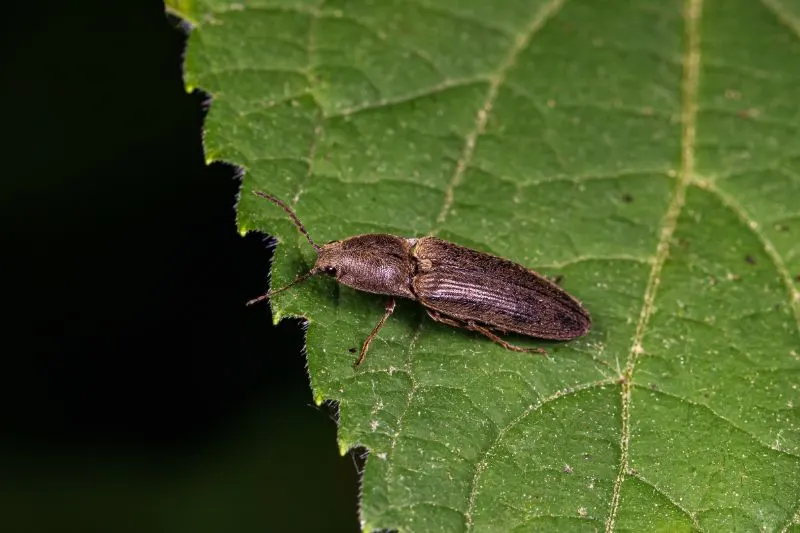
Click beetles, scientifically known as Elateridae, belong to the order Coleoptera. They are also commonly referred to as elaters, snapping beetles, spring beetles, or skipjacks. The outstanding characteristic of this family of beetles is the clicking sound they make when in danger or seized by a predator. With approximately 7,000 species globally, they exhibit a diverse range of appearances and habits.
Click beetles generally measure between 2.5 to 18 mm in length and come in varying shades of brown or black. Their elongated, parallel-sided bodies bear backward projections on the side corners of their pronotum (the shield behind their head). The size and color of click beetles vary depending on the species, with smaller species being about 1/4 inches long.
These beetles can be found in various habitats worldwide. They are primarily nocturnal insects that accidentally wander indoors or find their way during cold weather to seek shelter. Their diet consists of nectar, pollen, and small insects or arthropods.
The larval stage of click beetles, commonly known as wireworms, primarily feed on the roots of plants, which can cause significant damage to crops. Some wireworm species are considered pests due to the substantial losses they can cause to farmers’ yields.
Despite their noteworthy clicking ability, click beetles do not pose any significant threat to humans. If they find their way indoors, it is generally recommended to capture and release them outdoors.
Hercules
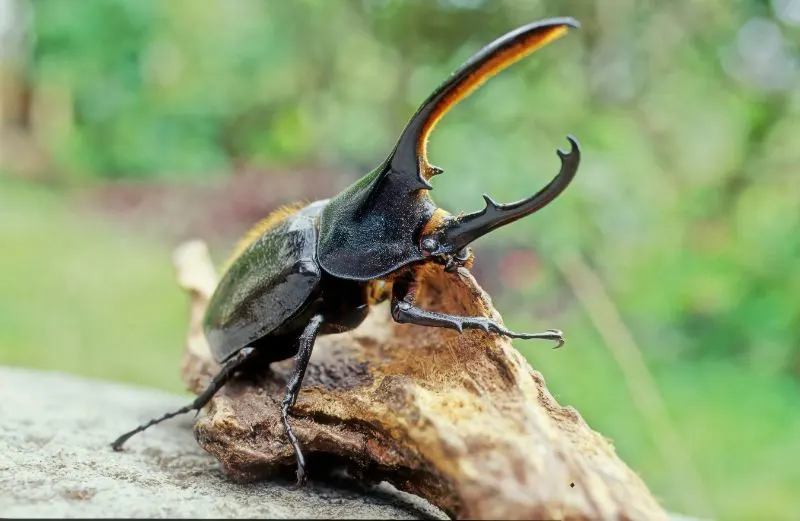
The Hercules beetle (Dynastes hercules) is an impressive and fascinating species of rhinoceros beetle, boasting a unique appearance with its distinct horn-like structures. They are nocturnal animals and can be found in a range of habitats, including mountainous and lowland rainforests from southern Mexico to Bolivia. Countries with known populations of Hercules beetles include the Lesser Antilles, Trinidad and Tobago, Brazil, Ecuador, Colombia, and Peru.
One of the notable features of the Hercules beetle is its size. Some species, such as the Hercules beetle, can grow to more than 18 cm (7 inches) long, of which 10 cm (4 inches) may be horn. The double horns are oriented vertically and resemble an enormous pair of pincers. These beetles are not only found in tropical regions, but can also be found in the United States in the form of Eastern and Western Hercules beetles, which are closely related to the tropical species but have some significant differences.
The life cycle of the Hercules beetle, although not entirely known in the wild, has been observed through captive research. These beetles have a larval stage that can last up to 2 years and go through 3 instars. The first instar lasts for 50 days, the second around 56 days, and the third for 450 days. During this stage, the larva can grow up to 11 cm long and weigh up to 100 g. After this, the larva enters a pupal stage that lasts for 32 days before developing into an adult beetle.
Atlas
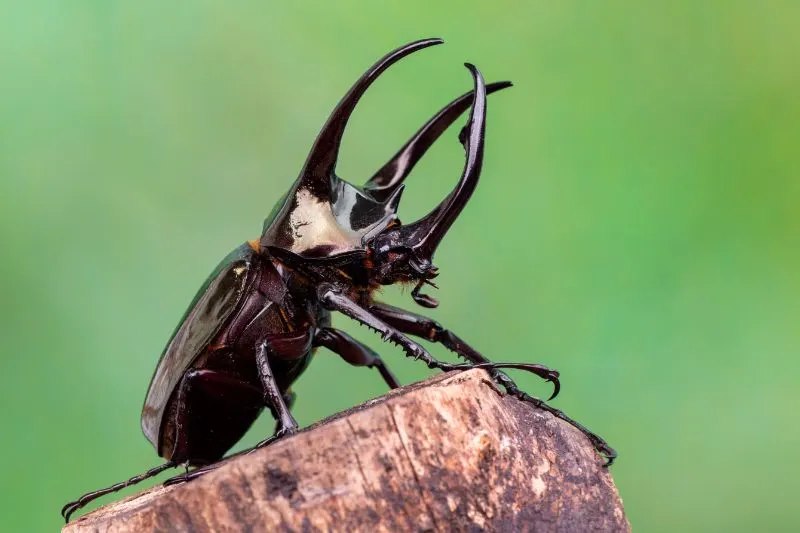
The Atlas beetle (Chalcosoma atlas) is an impressive species in the family ‘Scarabaeidae’, predominantly found in southern Asia, particularly Malaysia. Known for its remarkable size, this beetle can range between 25 and 145 millimetres. Notably, the male Atlas beetle is larger than the female, and typically, two males will engage in a battle for dominance.
As one of the largest beetle species, it can grow up to 4.7 inches, making it a popular choice among insect enthusiasts. The Atlas beetle’s size is not its only remarkable feature—its unparalleled strength relative to its size puts it among the world’s strongest animals. A fully grown Atlas beetle can reach 5 inches in length and weigh around 3.5 ounces (100 grams). Its lifting strength further solidifies its impressive standing in the animal kingdom.
The life of an Atlas beetle is not without potential threats. This beetle species is a host to the parasitoid giant scoliid wasp, Megascolia procer, which possesses a paralysing venom. Subspecies of the Atlas beetle include Chalcosoma atlas atlas (found in Sulawesi), Chalcosoma atlas butonensis (native to Buton Island), and Chalcosoma atlas keyboh (found in Malaysia and Sumatra).
Checkered
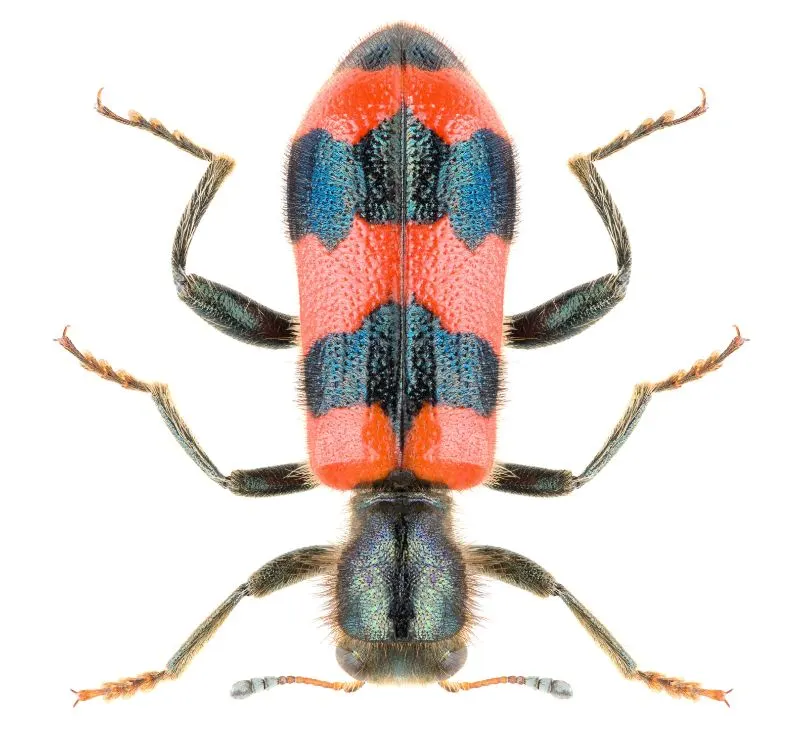
Checkered beetles, scientifically known as the family Cleridae, belong to the superfamily Cleroidea. They boast a diverse and worldwide distribution, inhabiting various ecological niches with an assortment of feeding habits. Commonly found in tropical regions, checkered beetles exhibit striking markings and vivid colorations, ranging from orange, red, yellow, green, and blue.
Measuring between 3 and 24 mm in length, checkered beetles have long, slender legs that resemble ants. The majority of species fall within the 5 to 12 mm range. Their body structure includes a wide head, tapered thorax, and elytra (hard wing covers) that are broader than the thorax. Both the larvae and adult checkered beetles exhibit carnivorous tendencies.
Checkered beetles can often be spotted on flowers and trees. As predators, they play a crucial role in controlling populations of other insects. Typically, their diet consists of various wood-boring insects along with other pests. By feeding on these pests, checkered beetles contribute positively to the overall health of their ecosystems.
Black Caterpillar Hunter
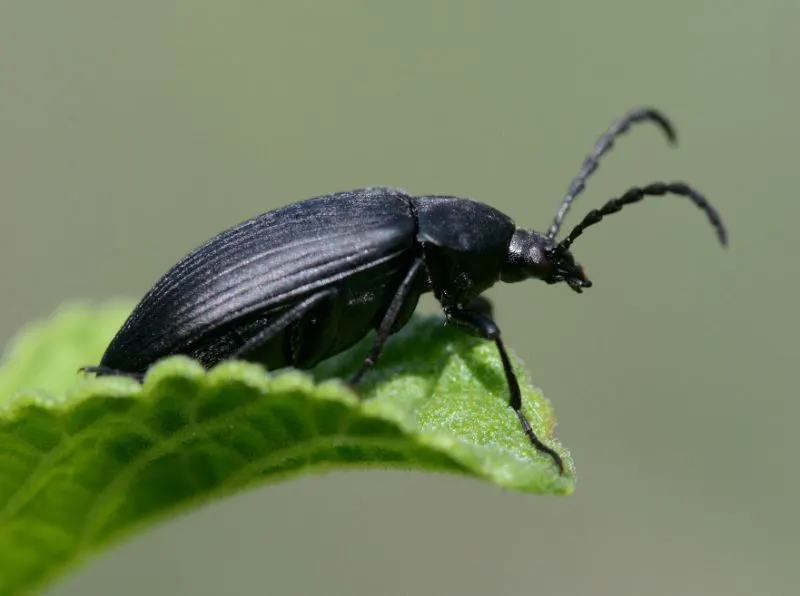
The Black Caterpillar Hunter (Calosoma genus) is a type of large ground beetle that primarily occurs throughout the Northern Hemisphere. As the name suggests, these beetles specialize in hunting and feeding on caterpillars, making them highly beneficial to gardeners and farmers who struggle with caterpillar infestations.
Belonging to the Carabidae family within the order Coleoptera, these beetles exhibit a generally black or metallic coloration and can range from 0.9 inches to 1.1 inches (25mm to 28mm) in size. Their ridged, lined bodies make them easily identifiable, and their powerful mandibles allow them to efficiently prey on caterpillars.
One notable species of Black Caterpillar Hunter is the Calosoma sayi, which is particularly fond of the Gypsy Moth caterpillar (Lymantria dispar). These beetles are also known to feed on army worms, making them a valuable natural predator to have in gardens and agricultural areas.
Black Caterpillar Hunters are equipped with glands near the tip of their abdomen that produce a foul-smelling spray as a defensive mechanism against predators. This spray, although unpleasant for humans, is not considered dangerous.
Tiger
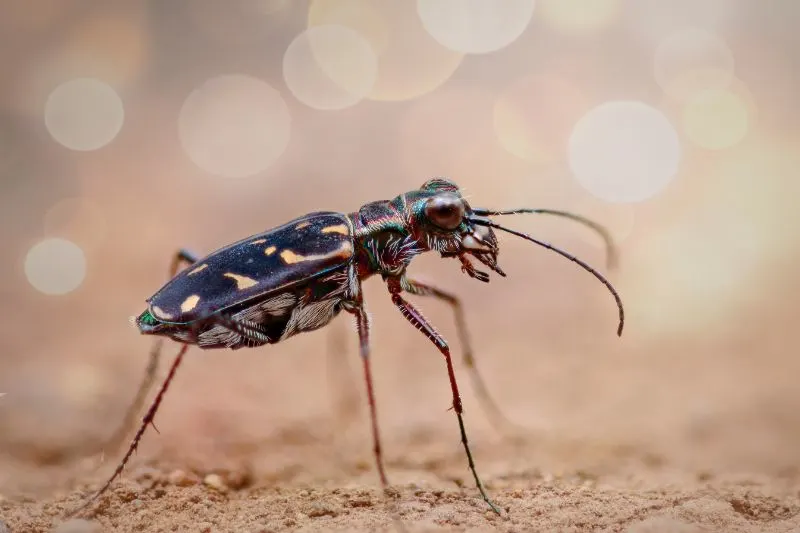
Tiger beetles are a diverse group of ground-dwelling predatory beetles known for their fierce hunting behaviors and striking appearance. Belonging to the subfamily Cicindelinae, these agile insects can be found across the globe, consisting of more than 2,600 species.
Tiger beetles are characterized by their large bulging eyes, long slender legs, and powerful curved mandibles. These adaptations enable them to effectively hunt their prey, which includes small insects and spiders. Indeed, their predatory efficiency has earned them the name “tiger” of beetles.
One remarkable feature of tiger beetles is their incredible speed and agility. Their long, thin legs help them dart across the ground in search of prey, quickly stopping and starting to adjust their movements. Some species of tiger beetles, particularly those found in the deserts of Australia, are among the fastest insects in the world.
Adult tiger beetles display a unique reproductive behavior, where males constantly search for females and females attempt to avoid or escape from males. Their larvae use ambush strategies, dwelling in vertical burrows and waiting at the top to catch unsuspecting prey.
Coloration and markings among tiger beetles can differ widely, with some species showcasing bright metallic hues, while others exhibit more muted colors. These variations often serve as a form of camouflage, helping them blend into their environment for both hunting and avoiding predators.
See Related: Amur Leopard and Tiger Alliance
Fiery Searcher
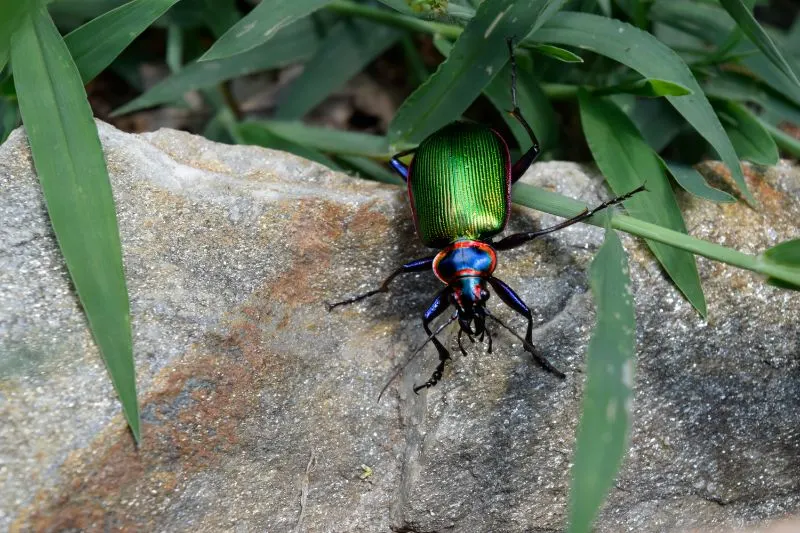
The Fiery Searcher (Calosoma scrutator) is a striking and beneficial beetle, celebrated for its visually appealing metallic green and reddish-orange appearance. Belonging to the Carabidae family, it’s one of the largest ground beetles in North America, with some specimens reaching up to 35 millimeters (1.4 inches) in length.
As a voracious predator, the Fiery Searcher actively hunts caterpillars in both its larval and adult stages. This makes it a valuable ally for farmers and gardeners looking for natural pest control measures. By preying upon various caterpillar species, the Fiery Searcher plays a vital role in lowering pest populations and protecting crops.
In addition to their hunting prowess, the Fiery Searcher has developed a defensive mechanism to deter potential predators. When handled, the beetle secretes a foul-smelling oil that resembles rotten milk or rancid olive oil. This unpleasant scent effectively discourages predators from attacking the beetle, allowing it to continue its role as a guardian of agricultural fields and gardens.
Some fascinating features of the Fiery Searcher include:
- Striking Appearance: The beetle’s deeply grooved metallic green elytra (wing covers) edged with lustrous reddish-orange make it easily recognizable among other beetle species.
- Predatory Nature: The Fiery Searcher is primarily carnivorous, feasting on various caterpillar species, boosting its importance as a natural pest control agent.
- Defensive Mechanisms: The secretion of foul-smelling oil, when threatened, provides a defense against potential predators.
While encountering a Fiery Searcher in your garden might be alarming at first, remember that their presence is beneficial. Their predatory activities help keep pest populations in check, and their stunning appearance adds a splash of color to any outdoor environment. So, if you spot a Fiery Searcher in your surroundings, do your best to coexist peacefully with these fascinating and environmentally helpful beetles.
Deathwatch
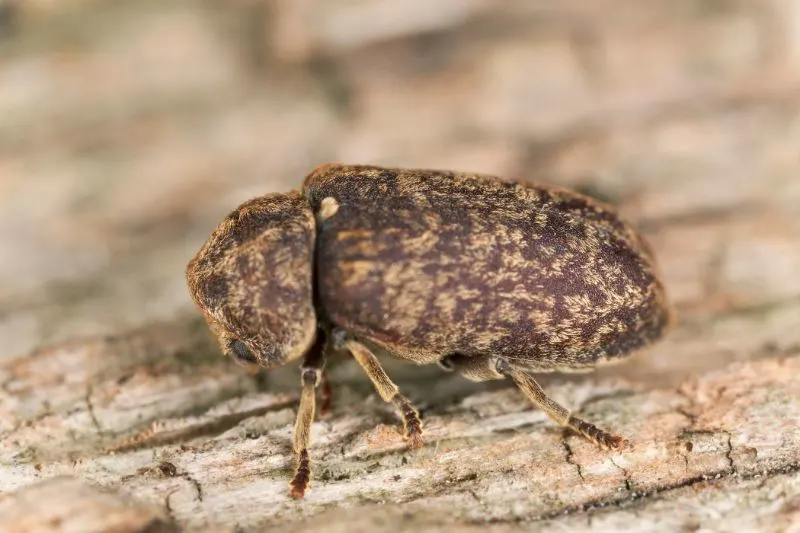
The Deathwatch beetle (Xestobium rufovillosum) is a medium-sized beetle belonging to the family Ptinidae, known for their wood-boring behavior. These insects typically measure between 5 and 9 millimeters in length, making them inconspicuous to the human eye. However, their distinct appearance sets them apart from other beetles in the insect kingdom.
The larvae of the Deathwatch beetle live in dead wood, old trees, and buildings. Their tunneling habits can cause major damage to wood beams, floors, and furniture, as they create small round exit holes with diameters ranging from 1 to 6 millimeters. These flight holes are formed after the woodworm larvae pupate and hatch into adult beetles, boring their way to the surface of the timber to mate.
One intriguing aspect of the Deathwatch beetle is the ticking or clicking sound it produces. This noise is made by bumping its head or jaws against the sides of the tunnels as the beetle bores through old furniture and wood. According to superstition, the sound was associated with an omen of death, giving the beetle its ominous name.
The adult Deathwatch beetles are most active between March and June. To preserve wood structures and furniture from damage, it is essential to address any infestations, using proper inspection, identification, and treatment methods. By addressing these infestations promptly, it is possible to mitigate the harmful effects of these fascinating yet destructive creatures.
Green June
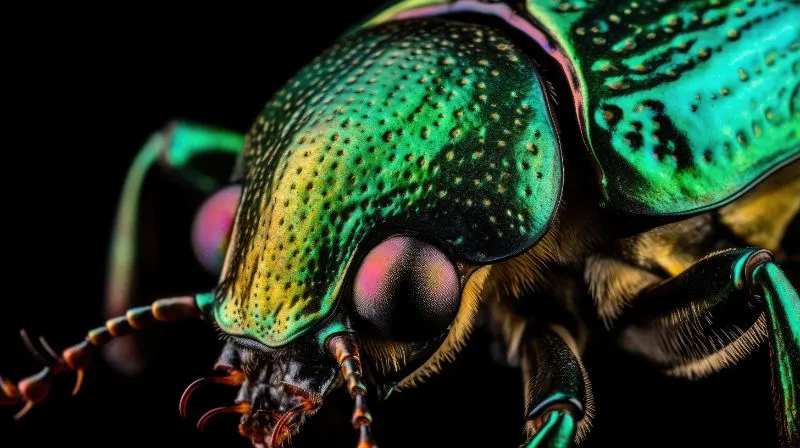
The Green June Beetle (Cotinis nitida) is a species of beetle belonging to the family Scarabaeidae. They are commonly found in the eastern United States and Canada, with the highest abundance in the South. These metallic green beetles are known for their striking appearance, featuring gold-yellow wing covers and bronze to yellow body margins. Adults are nearly 1 inch long, while grubs can grow from 1/4 inch to 2 inches long.
The Green June Beetle’s life cycle begins as eggs laid by females in soil. These eggs eventually hatch into larvae, also known as grubs, which primarily feed on humus and mold. However, they do occasionally damage plant roots, especially those that have been mulched. Grubs are cream-colored and noticeably larger than other white grub species. They are more elongate and do not curl into the characteristic “C” shape commonly seen in white grubs.
Adult beetles emerge in June and are strong fliers. While they are primarily attracted to ripe and decaying fruit, they can sometimes cause damage to foliage by feeding on leaves. In particular, they have a preference for figs and are occasionally referred to as fig-eaters. This should not be confused with the related Fig-Eater Beetle (Cotinis mutabilis) which is a separate species.
It’s important to note that the Green June Beetle plays a role in the ecosystem by helping to decompose organic matter. While they can cause damage to plants and turf, they also serve a purpose in breaking down decaying material. With a better understanding of these intriguing beetles, we can appreciate their place in the environment while still monitoring and managing their impact on landscapes.
Blister
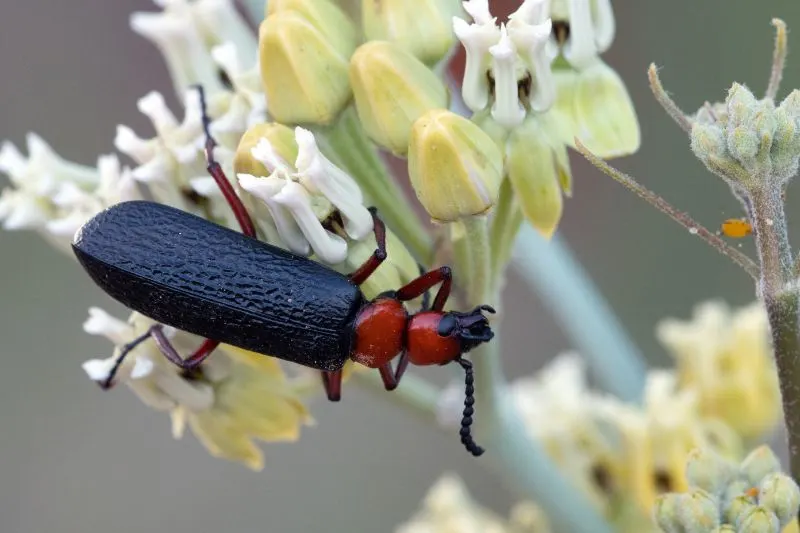
Blister beetles belong to the family Meloidae and are known for their defensive secretion of a blistering agent called cantharidin. There are approximately 7,500 species of blister beetles worldwide, with around 250 types found in the United States. They can be found in various regions including the east, south, midwest, the grasslands of the west and southwest, and gardens along the Pacific coast.
These beetles exhibit a diverse range of sizes and colorings. Many species are conspicuous and have aposematically colored patterns, which serve as a warning to potential predators of their toxicity. These bright colors and striking patterns help protect them from being consumed by predators such as birds and lizards.
Blister beetles are divided into different groups, such as Lytta and Pyrota. Although not closely related, both Lytta and Pyrota exhibit vibrant colors and conspicuous patterns to deter predators. Another example is the Epicauta species of blister beetles known for their distinct appearance and toxic cantharidin secretion.
Adult blister beetles feed on plants and can become pests in gardens, especially on crops like alfalfa. The cantharidin found in their hemolymph (the blood of insects) can cause significant skin irritation and blistering when it comes into contact with human skin. Handling these beetles requires care to avoid injury or exposure to the caustic cantharidin.
Sawyer Beetles
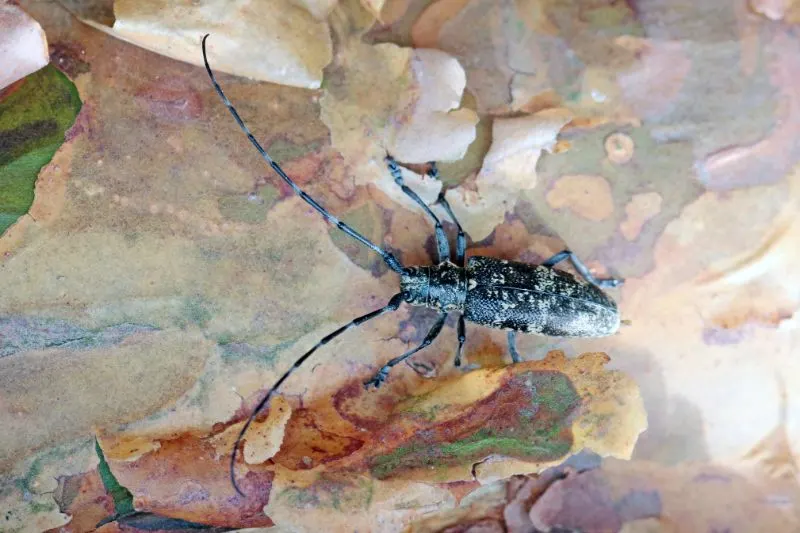
Sawyer beetles, belonging to the genus Monochamus, are a group of long-horned beetles commonly found throughout North America. These insects play an essential role in the ecosystem, and they are not harmful to humans.
The Sawyer beetles family comprises various species. Two species you might encounter in the northeastern region of the United States are the Whitespotted Sawyer beetle (Monochamus scutellatus) and the Northeastern Pine Sawyer (Monochamus notatus). The Whitespotted Sawyer, also known as the spruce sawyer, is native to the continent. Four subspecies of the Pine Sawyer beetle include Monochamus galloprovincialis cinerascens, Monochamus galloprovincialis galloprovincialis, Monochamus galloprovincialis pistor, and Monochamus galloprovincialis tauricola.
These beetles have a distinct appearance due to their long antennae and the presence of white spots on their bodies. The adults are known for their robust flying abilities, making them easily distinguishable from other insects. Their primary hosts are pine, spruce, true firs, and Douglas-fir trees. While the adult beetles feed on tree bark, their larvae are wood borers, causing damage to the host trees.
Sawyer beetles usually target weakened, dying, or recently dead trees in the forest. While their activities can cause damage to the host trees, they play a vital role in the decomposition process, returning nutrients to the soil and creating habitats to support diverse forest wildlife. Understanding the role of Sawyer beetles in the ecosystem is essential to weigh the benefits and risks of managing their population when necessary.
Emerald Ash Borer
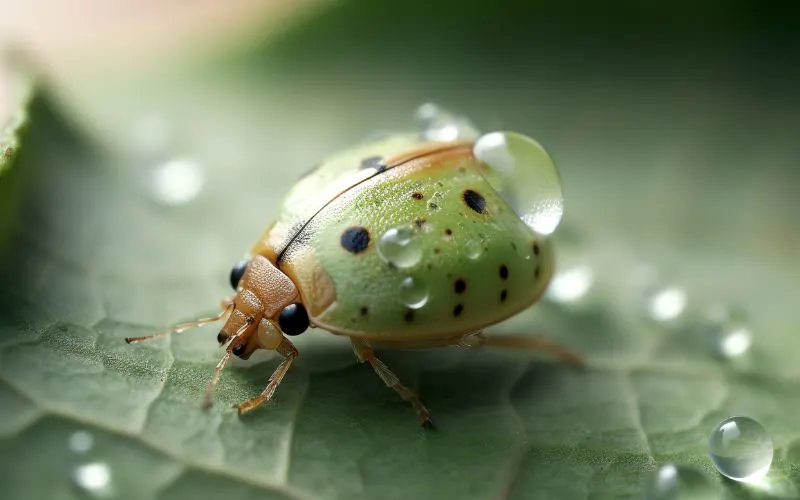
The Emerald Ash Borer (Agrilus planipennis) is a green jewel beetle native to northeastern Asia. It is known to feed on ash tree species (Fraxinus spp.). Female beetles lay eggs in bark crevices on ash trees, and the larvae feed underneath the bark. The larvae undergo a one- to two-year development process before emerging as adults.
This invasive beetle has caused significant damage to ash trees in various parts of the United States. The infestation has led to the death of tens, if not hundreds, of millions of ash trees. This widespread destruction has drastically altered some landscapes and communities, leading to ecological and economic consequences.
Several wood borers are commonly associated with ash trees. It’s important to distinguish between the Emerald Ash Borer and other species, such as:
- Ash/Lilac Clearwing moth borer (Podosesia syringae)
- Banded Ash Clearwing moth borer (Podosesia aureocincta)
- Ash Bark Beetle borers (Hylesinus species)
Among these borers, only the ash bark beetle species have multiple generations per season. Accurate identification is crucial for devising effective management and control strategies.
One method in combatting the Emerald Ash Borer employs the use of woodpeckers and citizen scientists. Woodpeckers are natural predators of this invasive beetle, and the collaborative effort among researchers, citizen scientists, and the birds themselves helps track and control the beetle’s spread.
See Related: Different Overfishing Solutions for Conservation
How Long do Beetles Live?
Beetles exhibit a wide range of lifespans, which often depend on the specific species, habitat, and environmental factors. The life cycle of beetles consists of four stages: egg, larval, pupal, and adult.
The egg stage is the initial phase of a beetle’s life cycle, during which the female beetle lays eggs, often in groups. Depending on the species, the duration of this stage ranges from a few days to several weeks. For instance, ladybird beetles lay eggs that hatch within 3-10 days.
Following the egg stage, beetle larvae emerge and begin feeding and growing. The larval stage can last anywhere from a few weeks to several years, depending on the species and environmental conditions. During this stage, the larvae may go through several molts, which enables growth and development. For example, the larval stage of a stag beetle can last between 3 and 5 years.
The pupal stage is the transitional phase, and it occurs when the larvae cease feeding and form a protective covering, known as a pupa, around themselves. Within the pupa, the larvae metamorphose into adult beetles. The pupal stage can last several weeks or months, again depending on the species and environmental factors.
Adult beetles are the final stage, and their lifespan varies significantly across different species. Some beetles, like the June bug, may live for only a few months, while others, like the longhorn beetle, may live up to 2 years. Factors such as predation, parasitism, and food availability can influence the adult lifespan of beetles.
Frequently Asked Questions
What are the most common beetle species?
There are several common beetle species that one may encounter, including the ladybug, ground beetle, and semi-aquatic beetle. Ladybugs, also known as ladybirds, are often found residing on plants, feeding on aphids and mealybugs. Ground beetles, on the other hand, prey on smaller insects and are often found along the ground. The semi-aquatic beetles, belonging to the Byrrhoidea superfamily, are typically small, black or dull brown insects not easily noticed by nature enthusiasts. Keep in mind, these are just a few examples of the myriad of beetle species found worldwide.
How many beetle species are there worldwide?
Beetles are the most common type of insect; there are approximately 30 different types of beetles, encompassing a diverse range of shapes, sizes, and behaviors. The beetle order, known as Coleoptera, is incredibly diverse and contributes significantly to the ecosystems of our planet, fulfilling various roles, such as pollinators and decomposers.
What is the classification of beetles from kingdom to species level?
The classification of beetles, like all living organisms, begins at the kingdom level and goes into increasingly specific categories. For beetles, the classification system is as follows:
Kingdom: Animalia (animals)
Phylum: Arthropoda (arthropods)
Class: Insecta (insects)
Order: Coleoptera (beetles)
Further classification occurs at the family, genus, and species level, with specifics depending on the particular beetle species being discussed. For example, the pine beetle, which can cause significant damage to pine trees, has the following classification:
Family: Curculionidae
Genus: Dendroctonus
Species: Dendroctonus ponderosae
It is important to note that there are hundreds of families and thousands of genera and species within the Coleoptera order, making beetles an incredibly diverse group of insects.
Related Resources:
- Are Beetles Bugs or Insects? The Definitive Answer
- Do Ants Drown? You Won’t Believe the Surprising Facts
- These Are The 13 Most Populated Animals in the World Influencing Climate Change


